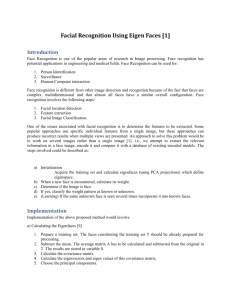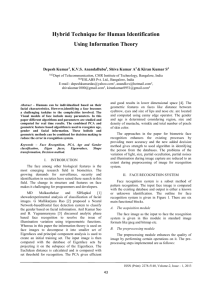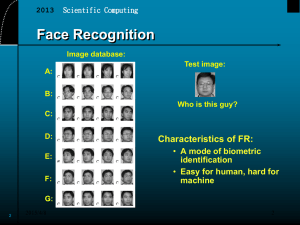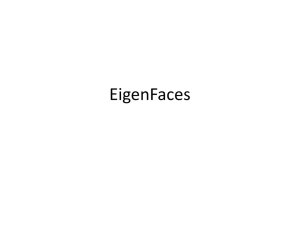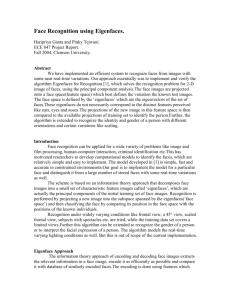L9(FacRecProj)
advertisement
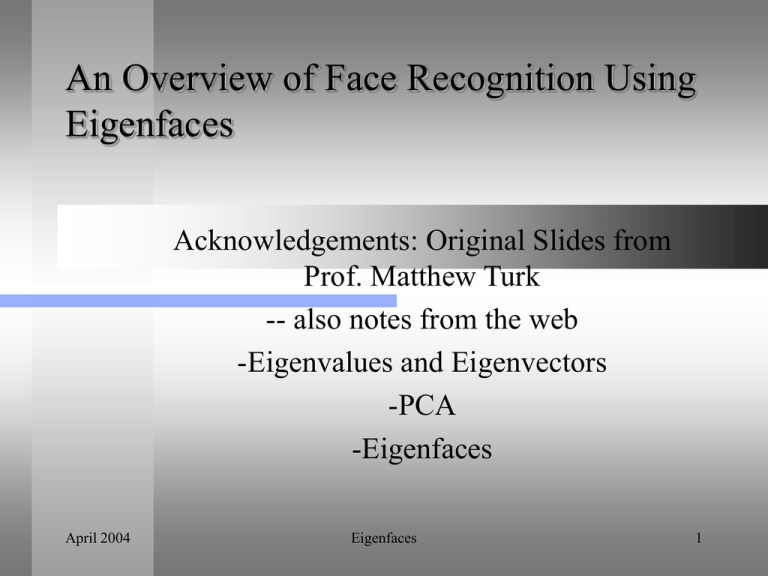
An Overview of Face Recognition Using
Eigenfaces
Acknowledgements: Original Slides from
Prof. Matthew Turk
-- also notes from the web
-Eigenvalues and Eigenvectors
-PCA
-Eigenfaces
April 2004
Eigenfaces
1
Outline
Why automated face recognition?
Eigenfaces and appearance-based approaches to
recognition
– Motivation
– Review
Why Eigenfaces?
Why not Eigenfaces?
Where shall we go from here?
Why Automated Face Recognition?
It is a very vital and compelling human ability
– Faces are important to us
– Severe social problem for people who lack this ability
It’s fun to work on
– Better than recognizing tanks and sprockets
Good, paradigmatic vision problem
It may actually be useful
– Biometrics, HCI, surveillance, …
They can do it in the movies!
Commercial Interest
Image and video indexing
Biometrics, e-commerce
– Visionics, Viisage, eTrue, …
Surveillance
– Casinos, Super Bowl, Tampa, FL
Automated Face Recognition
Typical formulations:
– Given an image of a face, who is it? (recognition)
– Is this an image of Joe Schmoe? (verification)
Why isn’t this easy?
The Problem
The human face is an extremely complex object,
highly deformable, with both rigid and non-rigid
components that vary over time, sometimes quite
rapidly and sometimes quite slowly
The “object” is covered with skin, a nonuniformly textured material that is difficult to
model either geometrically or photometrically
The Problem
Time-varying changes include:
– The growth and removal of facial hair, wrinkles and
sagging of the skin brought about by aging, skin
blemishes, changes in skin color and texture caused by
exposure to sun, etc.
Plus many common artifact-related changes:
– Glasses, makeup, jewelry, piercings, cuts and scrapes,
bandages, etc.
Not to mention facial expressions, changes in
hairstyle, etc.
The Problem
In general, object recognition is difficult because
of the immense variability of object appearance
Several factors are all confounded in the image
data
– Shape, reflectance, pose, occlusion, illumination
Human faces add more factors
– Expression, facial hair, jewelry, etc.
So… one may argue that face recognition is
harder than most object recognition tasks
The Problem
Overcoming these difficulties will be a significant
step forward for the computer vision community
So, face recognition has been considered a
challenging problem in computer vision for some
time now
The amount of effort in the research community
devoted to this topic has increased significantly
over the years (e.g., this workshop)
Real-time performance is key!
What is Face Recognition?
What can be observed via the face?
– Identity, emotion, race, age, sex, gender, attractiveness,
lip reading, character(?)
Does face recognition include hair? Ears?
Are people really very good at face recognition?
– Driver’s license photos
– Models in catalogs
– Colleagues at ICCV
Perhaps we don’t do it all that often
– Clothes, gait, voice, context
Quiz
How many women are in the following picture?
The Context of Face Recognition
Face recognition (in humans and machines) often
coexists with other face processing tasks:
–
–
–
–
–
Face (and head) detection
Face (and head) tracking
Face pose estimation
Facial expression analysis
Facial feature detection, recognition, and tracking
It may be unnatural to separate face recognition
from these other tasks
– But we will anyway…
Eigenfaces: Motivation
First generation of FR systems
– Locate features, measure distances and angles, create
feature vector for classification
– Bledsoe 1966, Kelly 1970, Kanade 1973
Mid-to-late 1980s – Is there a different approach
to recognition, perhaps making use of all the
image data (not just isolated features)?
features
???
Revisionary History
The “Eigenfaces” approach, based on PCA, was
never intended to be the definitive solution to face
recognition. Rather, it was an attempt to reintroduce the use of information “between the
features”; that is, it was an attempt to swing back
the pendulum somewhat to counterbalance the
focus on isolated features.
Motivation: Biological Vision
For decades, vision researchers have been
investigating mechanisms of human face
recognition
– Debate: Are faces special? I.e., does face processing
have a different neural substrate from other visual
recognition?
– Debate: Configural vs. holistic processing (featuredriven vs. whole stimulus integration)
– Evidence from many sources: psychophysics, singlecell recording, neuroimaging, neurophysiological case
studies
Example: Two face cells in monkey
Eigenfaces: Motivation
Biological face recognition
– Is face recognition configural or holistic?
– Previous approaches had all been configural
So… let’s try an appearance-based approach to
face recognition!
Appearance models are complementary to shape
models
– Not a replacement
Levels of Recognition/Matching
Abstraction
Model
Example
Shape
Shape
Features
Features
Pixels
Pixels
Eigenfaces origins
1980s Burt et al. pyramid-based FR work
1987 Sirovich and Kirby paper
– PCA-based encoding of face images
Real-time motivation
Is this a suitable representation for face
recognition? Detection? Multiple scales?
Multiple views? Is it computationally feasible?
So What is (are) Eigenfaces?
Uses Principal Component Analysis (PCA) to construct a
“Face Space” from a training set of face images
– Subspace of all possible images
– Encodes only face images
– Some choice in dimensionality
Test image is projected into the Face Space
– Projection distance determines “faceness”
– Classify according to projection coefficients
Efficient implementation for face detection and recognition
Explicitly handle scale and pose (simply)
Implicitly handle lighting, expression, etc.
Intuition
Image space is vastly large
– 8x8 binary image 264 image points (distinct images)
– 1 billion images per second 600 years
Assumptions:
– Images of particular objects (faces) may occupy a
relatively small but distinct region of the image space
– Different objects may occupy different regions of
image space
– Whole classes of objects (all faces under various
transformations) may occupy a still relatively small but
distinct region of image space
Morphing one face to another
Questions for Appearance-Based FR
What is the shape and dimensionality of an individual’s
“face space,” and how can it be succinctly modeled and
used in recognition?
What is the shape and dimensionality of the complete face
space, and how can it be succinctly modeled and used in
recognition?
Within the larger space, are the individual spaces separated
enough to allow for reliable classification among
individuals?
Is the complete face space distinct enough to allow for
reliable face/non-face classification?
PCA
PCA is a statistical technique useful for
dimensionality reduction
– Can be used to construct a low-dimensional linear
model from training data
– Optimal in a least-squares sense
– Assumes uniform noise (an isotropic noise model)
Minimizes a least-squares energy function
– Can be made robust (may be much slower) [Yuille,
Black, others]
– Probabilistic PCA [Tipping]
Computing Eigenfaces
Set of face images {xi} of several people
X x1 x2 x3 xM
Sample covariance matrix
1
C
M
M
1
T
x
x
XX
i i
M
i 1
T
Eigenvectors of C form the principle components
(Eigenfaces), ordered by the eigenvalues
Cei i ei , E e1 e2 e3 eM
Projecting Into Face Space
A potential face image (y) is multiplied by the
Eigenfaces
ET y
~y E
Distance from face space:
y ~y
Classification of Face Image
Simplest version: nearest class
arg min i
i
There are many better ways to do this!
E.g., identity surfaces
Experiments with Eigenfaces
Initial and subsequent empirical results have
shown promise
– Performs reasonably well with small variations in most
parameters (scale, pose, lighting, etc.)
Modular, multiscale and multiview approaches
Large database experiments
Early Arguments Against EFs
EFs is a poor man’s correlation, slightly more
efficient but not as good
– Only partly true
– Major benefits: generalization from learning, ability to
detect new faces, ability to handle very large databases
Features are much better for recognition than are
pixel values (lack of invariants)
– Examples and counter-examples
Some Issues Regarding EFs
How to select k, the number of Eigenfaces to keep
How to efficiently update the face space when
new images are added to the data set
How to best represent classes and perform
classification within the face space
How to separate intraclass and interclass
variations in the initial calculation of face space
How to generalize from a limited set of face
images and imaging conditions
Problems with Basic EFs
There are clear shortcomings with the early
Eigenfaces implementations
– Significant variation in scale, orientation, translation, or
lighting causes it to fail – they’re not really linear!
– Intra- vs. inter-class mixture
– Not robust – bad images and bad pixels create havoc
– Sensitive to precise alignment of the training set
– Main encoding seems to be illumination
– Poor understanding of training dependencies
– Many, many more……..
Bichsel
So this is Why Eigenfaces Work
To be more accurate… Appearance-based techniques work
–
–
–
–
–
PCA, PCA+LDA, AAM, ICA, etc.
Relatively simple to implement and train
Works well in controlled environments
Can be made real-time – runtime is usually the faster part
Straightforward to comprehend and debug
Especially when combined with feature- or shape-based
information!
– E.g., shape- and pose-free techniques
Where to Go From Here?
Better understanding of learning
– Implications/requirements on size and diversity of
training set
– Convergence properties
– Sensitivity and robustness
Better integration with feature- and structurebased techniques
Continued work on intra- vs. inter-class modeling
Continued work on illumination modeling
(beyond lambertian)
Where to Go From Here? (cont.)
Deep understanding – not just application of latest
hot PR techniques
Better understanding of the relationship among
inner face, hair, ears, contour, etc.
Dynamic and static approaches
Integration with other sources of knowledge
(voice, gait, clothes, environment)
Continue to pursue non-linear approaches
Push toward real-time, interactive
Where are We Now in FR?
Still a long way to go
Still many good, hard, interesting problems to
solve
But we have come a long way in the past ten years
